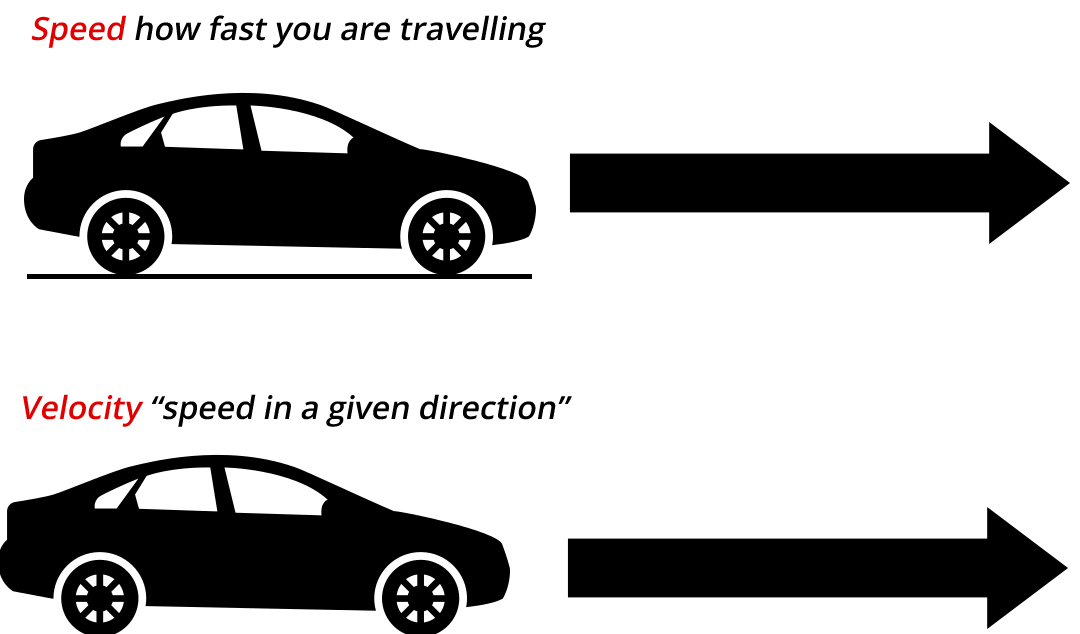As distance and shift have distinctly different meanings (despite their similarities), so do speed and speed. Speed is a scalar quantity that identifies "how fast a subject is moving. " Acceleration can be thought of as the rate at which an object covers a distance. A fast-moving subject has a high speed and includes a large distance in a quick amount of time. Contrast this to a slow-moving subject with a low acceleration; it covers a relatively tiny amount of distance in a similar amount of time. An object without having movement at all has actually zero speed.

Photo Credit : CoolKidsFacts.com
Velocity as Vector Quantity
Determining the Direction of the Velocity Vector
The work of expounding on the direction of the speed vector is easy. Typically, the direction of the speed vector is simply just like the direction that an object is moving. It may well not matter regardless of if the target is accelerating or slowing down. Throughout the event that an object is moving rightwards, then its velocity is identified as being rightwards. In the event that target is moving down, then its speed is identified as being downwards. So an airplane moving towards the west with a speed of 300 mi/hr has a velocity of 300 mi/hr, western world. Note that swiftness is without direction (it is a scalar) and the speed at any instant is simply the speed value with a direction.
Determining Average Speed and Average Velocity
Being an object moves, trying to undergoes changes in speed. With regard to example, during a typical trip to college, there are many changes in velocity. Rather than the speed-o-meter maintaining a steady reading, the needle constantly techniques up and down to reflect the stopping and starting and the speeding up and decelerating. 1 instant, the vehicle may be moving at 50 mi/hr and another instant, it might be ended (... zero mi/hr). Yet during the vacation to university the person might average 32 mi/hr. The average acceleration during a complete motion can be thought of as the regular of all speedometer readings. In the event that the speedometer blood pressure measurements could be accumulated at 1-second times (or 0. 1-second intervals, or... ) and then proportioned together, the average speed could be determined. Now that would be a lot of work. And fortunately, there is a magic formula.
The average speed during the course of a motion is often computed using the following formula:
In contrast, the average velocity is often computed using this formula.
Q: While on vacation, Lisa Car traveled a total distance of 440 miles. Her trip took 8 hours. What was her average speed?
To compute her average speed, we simply divide the distance of travel by the time of travel.
- Instantaneous Acceleration - the acceleration at any presented instant in moment.
- Average Speed instructions the regular of most instantaneous speeds; located simply by some sort of distance/time ratio.
It might seem of the fast speed as typically the speed, how the speed-checking device reads any sort of time presented instant on time plus the average velocity as the typical of all of the speedometer psychic readings throughout the journey. Because the task associated with averaging speedometer psychic readings will be very complex (and maybe actually dangerous), the typical speed is much more generally calculated since the distance/time ratio.
Moving items don't always journey at erratic plus changing speeds. Sometimes, an object will certainly move at a steady rate along with a continuous velocity. That is, the thing will cover the particular same distance each regular interval associated with time. For example, a cross-country athlete may be running along with a continuous velocity of 6 m/s in a directly line for a number of minutes. If the girl speed is continuous, then the range traveled every 2nd is the exact same. The runner might cover a range of 6 meters every second. In case we could determine her position (distance from an irrelevant starting point) every second, then all of us might note that will the position will be changing by six meters each 2nd. This would become in stark comparison to an item that is altering its speed. A good object having an altering speed will be shifting a different range each second. The information tables below illustrate objects with continuous and changing velocity.

